In Walt Disney Animation Studio’s animated feature Strange World, a legendary family of explorers attempt to navigate an uncharted, treacherous land alongside a motley crew. During the journey, Searcher Clade (Jake Gyllenhall) and his son Ethan (Jaboukie Young-White) are reunited with Searcher’s long-lost father, Jaeger (Dennis Quaid). After witnessing incredible sights and battling countless hostile organisms, they finally discover the incredible truth – all this time they have been journeying inside the body of a giant cosmic turtle, on whose back Avalonia rests.
From the start, the Disney Animation team recognized the importance of close collaboration between departments. The effects team worked hand-in-hand with environments, animation, layout and crowds to design and integrate effects that felt organic to the world. Houdini’s procedural tools allowed the team to develop flexible assets and workflows adaptable to the needs of downstream departments.
“Our artists leveraged Houdini to create a dazzling array of effects,” Kaschalk commented, “from the mysterious Pando Pulse and the threatening Acid Lake, to the flocking and swarming of Terrordactyls and Macrophages. We utilized SOPs and VOPs, and made extensive use of the Vellum solver to build complex organic effects that supported the story, and both augmented and animated the environments. We leveraged the proceduralism of Houdini to implement efficient automation across hundreds of shots.”
The team pushed new boundaries with techniques such as Volumetric Neural Style Transfer, and used Houdini to art-direct volumetric effects in novel ways. “Innovation in service of storytelling was the guiding principle,” asserted Kaschalk, “with every effect meticulously crafted to immerse the audience and support the emotional journey. These remarkable achievements are a testament to the dedication and inventiveness of this exceptional crew.”
Pando Pulse
The team created a procedural system to drive the pulse using Houdini’s powerful POPs network. “We designed it to flow from an array of different complex environmental assets,” explained Berberov, “including thousands of branches and vines.” Additional elements further enhanced the pulse. “We used the initial particle simulation source to drive Vellum fabric simulations and shader manipulations. This created the overall aura and glow that gives the Pando Pulse its distinct look and feel.”
Pando Zaps
Whenever they feel threatened by outside forces, the roots of the mystical Pando plant defend themselves by zapping invaders with aggressive jolts of energy. The ‘Pando Zap’ effect appears multiple times across many sequences, deployed initially as a defensive measure against entities such as Terrordactyls and Macrophages, and later when the film’s heroes launch their own offensive against the roots.
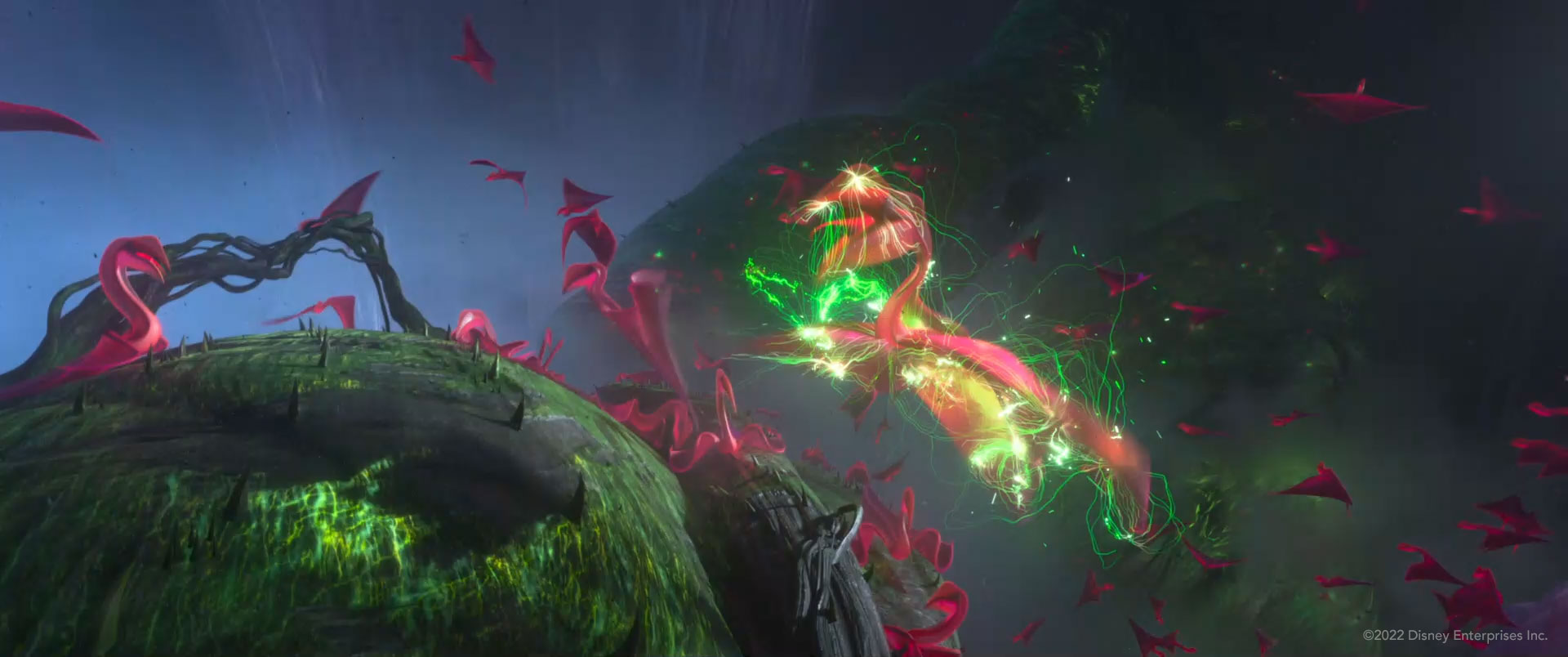
To generate the Pando Zaps, the effects team took an instance-based approach driven by the animation of the invading characters. In the case of the Terrordactyls and Macrophages, these invaders were agents within a crowd. “We fetched the animation cycle frame to identify the correct trigger time and contacting point for each zap effect,” said effects artist Joyce Tong. “We simulated multiple variants of the zap at world origin, then used our in-house instancer, Aurora, to place the effect at the correct location, scale, and time to match the crowd characters.”
Pando Thrower
The heroes of Strange World use the power of Pando to fuel an exotic breed of flamethrower known, appropriately enough, as the Pando Thrower. The effects team expanded the capabilities of Houdini’s native pyro tools using Volumetric Neural Style Transfer (VNST). Developed by Disney Research Studios, this machine learning-based process is an advancement from traditional Neural Style Transfer, which is used solely to manipulate 2D images.
“The primary challenge in bringing the Pando Thrower to life was integrating distinctly different natural phenomena into a single visual effect,” said effects lead Mike Navarro. “We needed to generate pyro simulations for the weapon’s energy stream, and further process them to take the shape of branching arcs of electricity and energetic particles.”
Navarro and his team stylized the pyro volumes by running them through VNST, which reshaped the 3D volumes with textures and features extracted from a 2D-style image. The team established a custom VNST pipeline based on Houdini’s native tools. “This allowed us to process volumes from pyro simulations,” explained Navarro. “It also enabled us to manage complex camera movements, especially crucial for dynamic shots aboard a moving airship.”
The VNST stylization process ran outside Houdini. However, a custom effects Houdini Digital Assets (HDA) extension gave animators control over VNST setup and job distribution, plus the ability to tune style parameters, while still working entirely within the Houdini interface. “It was important to make the overall setup as artist-friendly as possible,” Navarro noted.
Houdini’s procedural nature allowed for the seamless integration of multiple VNST passes. “We developed a method to blend multiple stylizations within the same volume,” said Navarro, “by generating custom volume masks from the age attribute of advected particles. This enabled us to control the blend of multiple styles using a single volume wrangle node.”
The VNST process proved to be computationally intensive, requiring significant GPU resources. The effects team prepared and distributed tasks from within Houdini across the GPU infrastructure, then seamlessly re-integrated the stylized volumes back into Houdini.
Acid Lake
During their fantastic voyage, the heroes navigate the airship Venture through a cavernous tunnel that ultimately turns out to be the stomach of the giant turtle on which Avalonia resides. Five miles long, the tunnel is filled with 400 billion gallons of stomach acid, a toxic lake roiling with giant waves and spewing deadly geysers.
To deal with the tunnel’s immense size, the effects team divided it into six segments, based on dramatic events represented in the storyboards. Each segment was designed and simulated separately using distributed Houdini FLIP fluid simulations. “We animated the tunnel walls procedurally in Houdini to create the large waves that the Venture avoids,” said effects lead Debbie Carlson. “We sent low resolution proxies of these simulations to the layout and animation teams, which they used to scout and animate the sequences.”
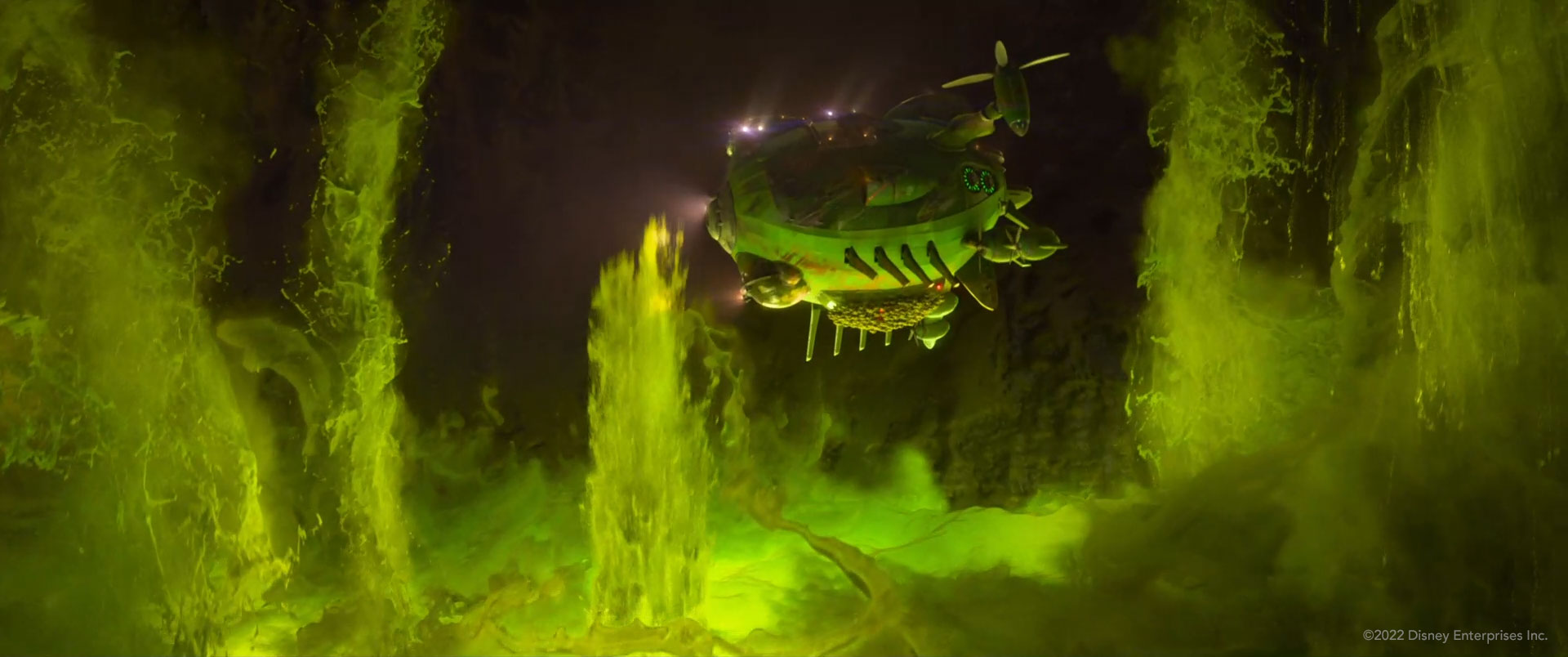
The effects team also created a variety of individual art-directable geyser simulations, as well as independent simulations of acid falls at the tunnel’s entrance and exit. “Once the shots had been created in layout and animation,” Carlson related, “we used a guided FLIP simulation technique in Houdini to create our final high resolution acid simulations from the base event simulations. We then simulated white water and mist elements and added them to the shots.”
Cloud O'Wars
As the Venture continues its exploration of the mysterious world, it encounters a shoal of huge flying creatures called ‘Cloud O’ Wars.’ These fantastic, fluffy organisms are an inspired mashup of natural cloud formations and Portuguese man o’ war jellyfish.
Production art direction established the overall color and form of the floating behemoths, with detailed character design left largely in the hands of the effects team. “Animation gave us a spartan initial model representing the loose bounds and motions of this ethereal beast,” said effects artist Scott Townsend. “We decided that different parts of the body would be expressed through different cloud types.”
Using SDFs of the various Cloud O’ War body parts, effects artists carved and sculpted unique noises appropriate to each cloud type. “We used the surface field values to create custom ramps that boosted noise density on the inside,” Townsend explained, “and gradually eroded off the noise so that when it reached a certain distance above the model surface it was entirely gone.”
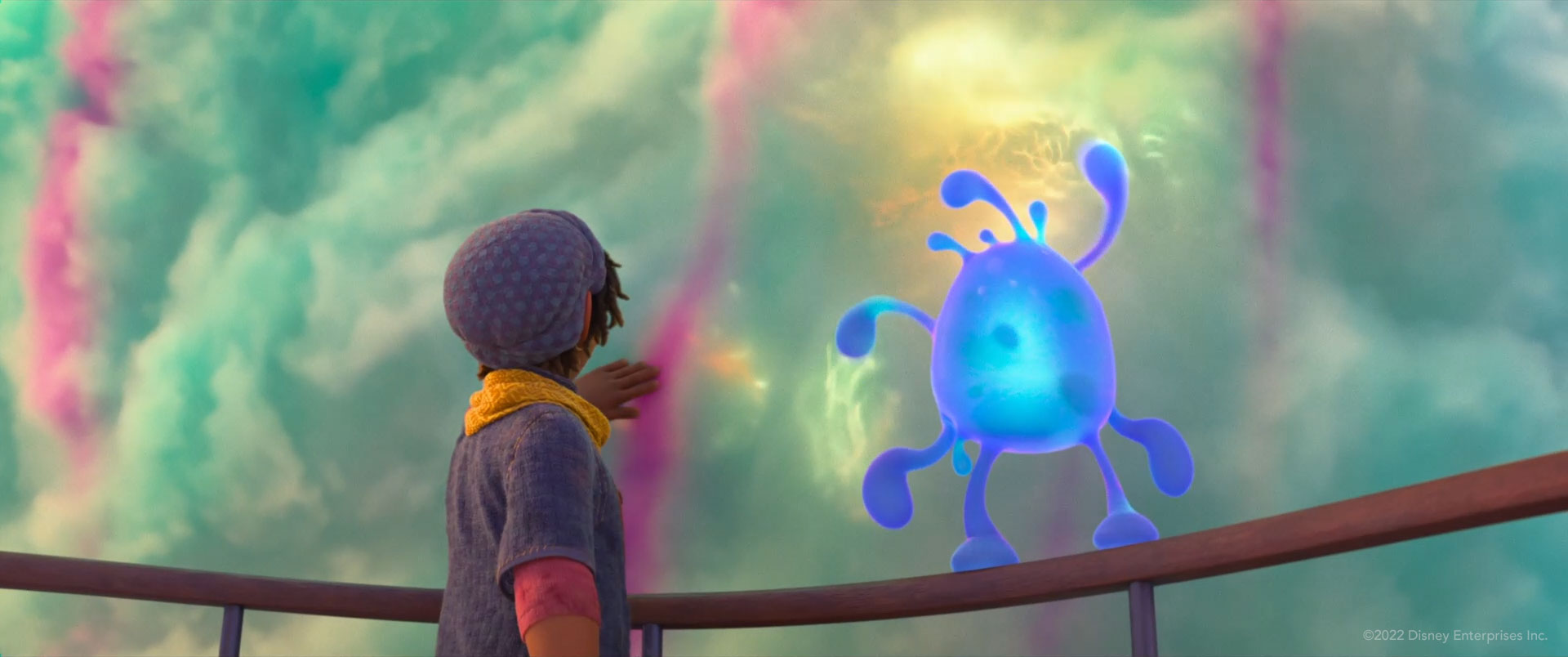
The art direction called for a visible pulse that originates in the body and travels down the trailing tentacles. Inspired by similar pulses seen in terrestrial jellyfish, these colored ‘heartbeats’ added extra depth and character to the Cloud O’ War volumes. “We modeled small nerve-nets in the main body and along the tentacles,” said Townsend. “Then we pulsed them to create the heartbeats. We did all the cloud-sculpting and light pulsing on a rest position, then subsequently deformed the volumes and geometry into their animated positions.”
As the Venture drifts through the Cloud O' War shoal, Ethan and his mischievous blob friend Splat reach out to touch them. The contact disrupts the giants’ nebulous bodies and draws wisps of cloud out into the surrounding air.
To achieve this subtle interaction, the effects team took the novel approach of converting the volume voxels to Vellum grains, which were then glue-constrained together. “We also made a Vellum balloon-core from an eroded version of the Cloud O’ War,’ Townsend elaborated. “The voxels-to-Vellum grains nearest the balloon surface were constrained to it. We simulated this balloon core, minus the grains, interacting with oversized character colliders to create gentle shape-restoring undulations.” A second simulation focused only on the Vellum grains. All the simulated grains were then rasterized back into a volume.
“We wanted to add further magic to this tranquil moment of contact,” added Townsend, “so we decided to add an interaction glow. We used a custom solver to accumulate, and gradually subtract, cloud grain acceleration.” The fading graduations produced by the solver drove color and brightness ramps for emission. “The end result was a series of graceful glowing trails that form as Ethan and Splat brush the surface of the Cloud O’ War.”
Alive Air
In Strange World, the air is filled with millions of tiny living microorganisms. “We sometimes referred to it as Alive Air,’ commented effects lead Stuart Griese. With hundreds of shots featuring these suspended microbes, the effects team developed a fully automated Houdini rig that could be run from the command line. “The rig handled everything from workspace and scene setup, to network customization, rendering, and publishing data for downstream departments.” The team deployed the same rig for later sequences requiring the generation of airborne ash particles.
Each story sequence – and occasionally individual shots – required different treatments, depending on the tone of the sequence and the demands imposed by dramatic camera movements. “We built the rig to expose nearly 40 node parameters as global variables,” stated effects artist Christopher Hendryx. “These could be adjusted by the automation tools at runtime to adjust the look for each shot.” Artists adjusted the parameter variables using command line tools at sequence level, applying a uniform look for an entire story beat, or adjusting individual shots at a more granular level while still picking up any changes made at sequence level.
“The tools enabled artists to work on hundreds of shots without the need to manually open and update each scene’s file,” noted Stuart Griese, “while still being able to dial in the look with controls ranging from particle density, size, wind speed and turbulence, colliders, LOD cutoff distances, and more.”
Cilia and Plant Motion
Because of the unique storyline of Strange World, the entire environment had to feel like a tangible landscape that lives and breathes. “The audience really needed to be immersed in the unexpected,” said animated environments supervisor Benjamin Fiske. “They needed to discover alongside our main characters how unpredictable, dangerous and beautiful this world truly was.” Established specifically to handle the motion of this environment, the animated environments department relied heavily on Houdini’s proceduralism for the creation, animation and lighting of various otherworldly flora and fauna, including over 50 “plants.” “From environments to layout, character animation to effects, the understanding was that anything was possible, provided the right solution could be found. This ethos opened the entire team up to new possibilities and discoveries.”
Each plant had its own unique motion, initiated by the environment modeling and look teams and carried through by the animated environments department. “We used Houdini to build out dozens of animation cycles,” explained Fiske. “Working closely with artists in the effects department, we leveraged fully procedural techniques, key-framed animation and, of course, Vellum simulations. These cycles were populated as they left rough layout, which allowed motion to be visible in the environment far earlier than was previously possible.” New pipelines were built to support the use of the animation cycles. “Any department in the pipeline could adjust the cycles in strength, speed, and offset, although this was done primarily by the final layout team.”
Early in his exploration of this imaginary world’s Windy Jungle, Ethan comes across a forest of aptly-named Lung Trees. The effects team collaborated with character animators to develop the movement of these respiring giants. Artists employed an HDA that leveraged a SideFX Labs skeleton. “We pulled curves from the complex branching structures,” said Fiske. “We created a gentle upward swelling by using those curves to drive procedural inflation motion up the tree.”
Separate Vellum simulations allowed the tree to droop and, when layered in backwards in sync with the breathing, caused the tree to inhale and become more alert. The tree’s iconic inflating balloons were simulated using Vellum pressure solves, timed to work with the tree’s motion. “Houdini allowed this process to be run across all 18 variants of the Lung Trees in just a few hours, all with synchronized timing,” Fiske stated. “Departments throughout the pipeline took special care to ensure all trees not only stayed in sync, but also lined up correctly in their cycle from shot to shot.”
Alongside these breathing forests, Strange World has its own peculiar version of meadows. In place of grass and regular flowers, these rolling fields are covered in constantly moving rubbery pink cilia interspersed with tall dandelion-like plants
The meadows were generated using Disney’s Bonsai procedural vegetation tool, first developed for the animated feature Frozen and primarily used for trees. Artists interfaced with the cilia fields using new LOP nodes built by Houdini TD Kenji Endo. Benefits were twofold. “The LOP nodes allowed artists to import the instance points and curves driving the render-time motion,” observed Fiske. “They could also pick up departmental texture overrides using embedded TOPs networks.”
Using the imported curves, artists animated the cilia using Vellum to drive interaction with characters. Stuart Griese built a rig to facilitate this. “Stuart’s rig let you isolate out the action area of a given shot,” Fiske explained, “then run a simulation against character motion and blend that motion back into the swaying movements shared by the rest of the cilia across the shot.” Only a small number of cilia was actively simulated in any given shot. “The rest of the simulation was done using large repeatable tiles of simulated cilia. This allowed large-scale curl noise to be visible blowing across the field. Everything was packaged up as a rig, then run and rendered automatically by the pipeline whenever character animation was published. This allowed for daily feedback of cilia interaction shots.” Ultimately, all 200-plus shots of the cilia were handled by a single artist.
Destruction
Disney’s previous film, Encanto, required effects lead Francisco Rodriguez and software engineer Brent Burley to develop a new rendering technique for destruction sequences, called Fracture-Aware Tesselation of Subdivision Surfaces. Used strictly for rigid body dynamics, this allowed artists to model, fracture, and simulate lightweight geometry, then render the results as smooth subdivision surfaces post-simulation.
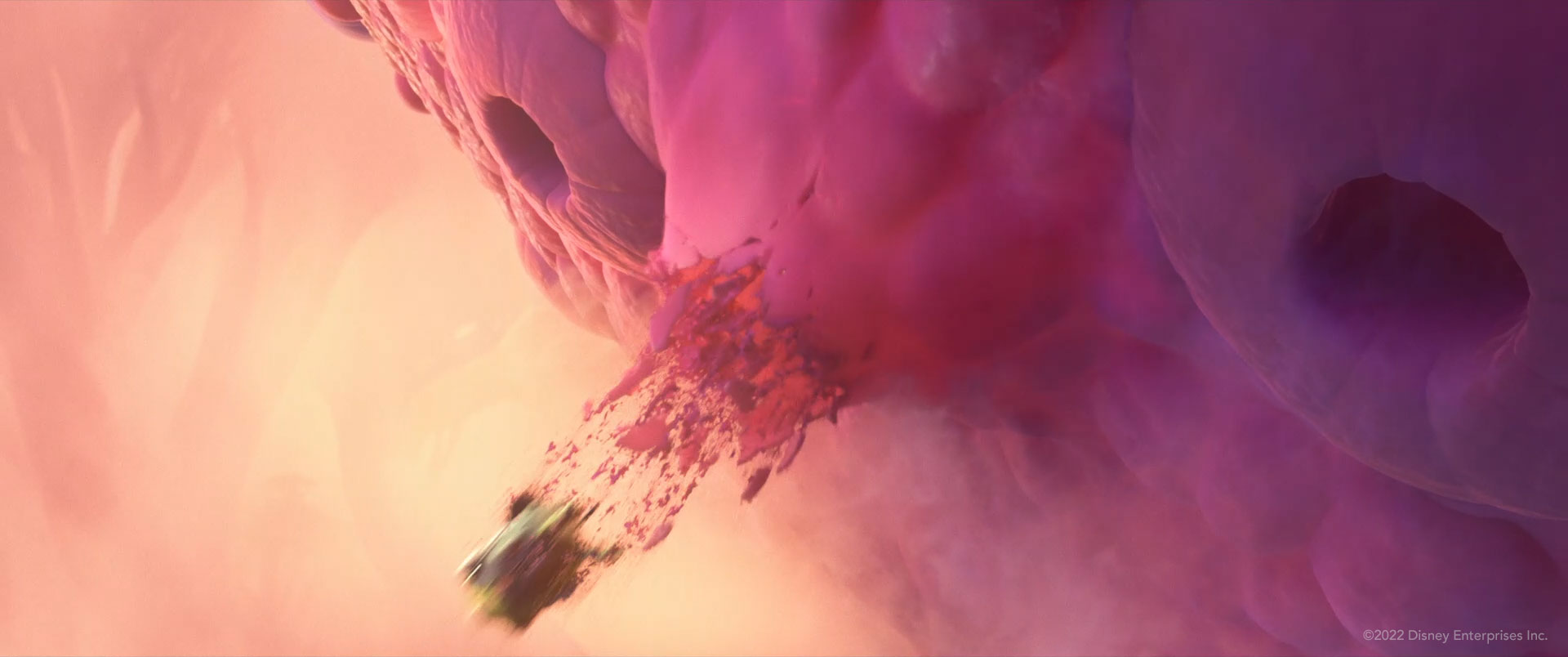
Set in an organic realm where practically everything lives, breathes or squirms, Strange World presented the team at Disney with a brand new set of challenges. The constantly deforming topology meant artists needed the ability to fracture, simulate, and render soft bodies. “We had to maintain the texture and material fidelity as surfaces squashed and stretched,” said Rodriguez. “We continued to take advantage of Houdini’s LOPs workflow to arrange the primitives, hierarchies and attributes in a way that would work efficiently with Disney’s Hyperion renderer.” The team upgraded the previously-developed Fracture-Aware Tesselator to handle these new requirements. “We used Vellum to simulate thin and thick membranes, along with other sorts of strange biological features. We were able to freely render pre-fractured soft bodies while maintaining crisp, seamless edges at fractures, as well as allowing for subsurface scattering.”
Flamethrower
Lost for years in the exotic wilderness of Strange World, Jaeger Clade builds himself a flamethrower to hunt wild creatures and keep himself safe. The effects team used Houdini to generate the gouts of flame belched out by this Rube Goldberg contraption.
“Our aim was to create a fire that had style but still maintained a realistic feeling,” said effects artist Tom Sirinaruemarn. “We tossed around a bunch of ideas before settling on a brushstroke look, drawing inspiration from oil paintings.” The team used Houdini’s Pyro solver to simulate fire, translating temperature fields into geometry, then generating polygon curves from the geometry and advecting those curves with custom directional fields. “Next we created VDB volumes from thousands of polygon curves with diverse features such as size, color and opacity.”
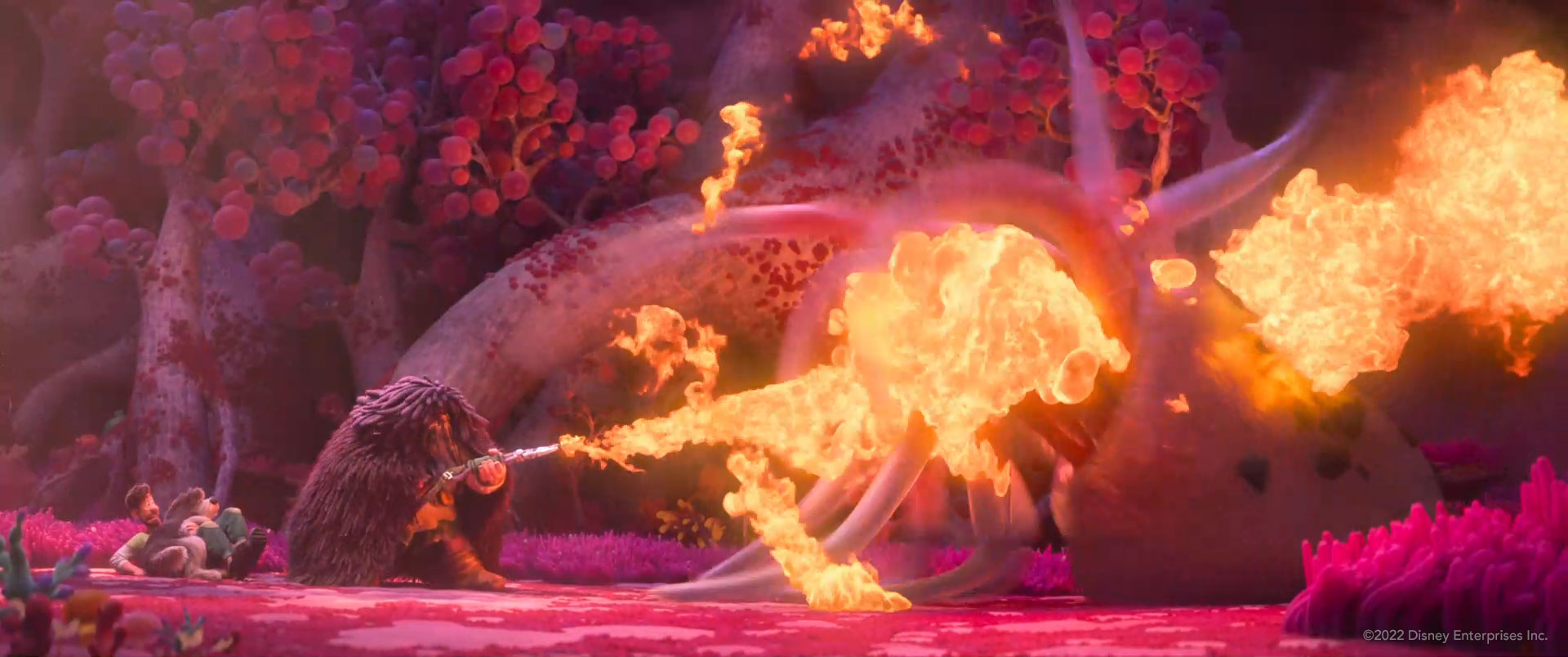
Render passes of the volumes were finalized in the compositing process. “We had a flamethrower rig inspired by Houdini’s Pyro Trail SOPs,” Sirinaruemarn commented. “This provided artists with the tools to manipulate the projectile motion, length, width, and speed of the Pyro sources that were fed into the Pyro solver.”
Goblinswills
During one of Strange World’s many high-octane action sequences, the heroes race along a treadmill-like stream formed from thousands of individual creatures resembling blood cells, known as Goblinswills. Dubbed ‘Chase in the Windy Jungle,’ the sequence demanded significant modifications to the traditional linear workflow used for crowds simulations.
The layout team composed each shot using a custom rig to constrain temporary crowds assets. The crowds team replaced this with a fine-tuned performance, then delivered a small section of the Goblinswill stream to the animation department for the addition of the main characters. “In order for the animators to work with large quantities of the blood cell creatures,” said crowds artist Alberto Luceño Ros, “we provided a lightweight mesh representation to act as a ‘ground plane.’ This allowed animation to produce the final performance for the main characters while crowds finalized the entire bloodstream performance.”
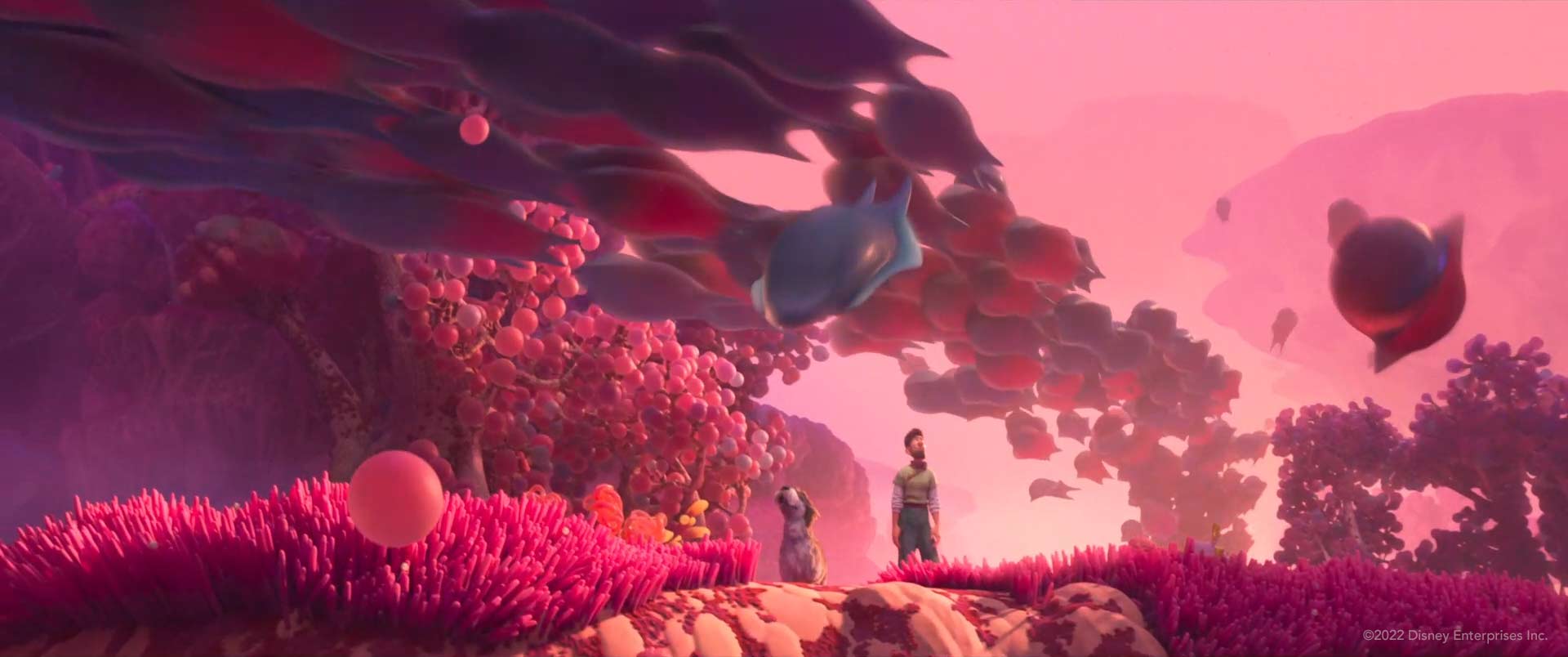
The Goblinswill streams feature prominently in over 100 shots throughout the film. Many of the sequences involve complex interaction with the film’s protagonists. “Due to the creative importance of these streams,” remarked Luceño Ros, “we had to develop an approach that offered precise art-directed control while still efficiently producing a consistent look.” To this end the crowds team built a procedural system based on frame-agnostic kinematic principles. This allowed fast, predictable and customizable calculation for each asset in the stream. “Houdini’s procedural node-based environment proved to be up to the job.”
An additional procedural module prevented collisions between the densely-packed Goblinswills, providing separation by interactively squashing and stretching each asset in response to its closest neighbors. “An ancillary set of tools facilitated the refining of individual blood cell performance and composition,” said Luceño Ros. “This procedural approach provided the consistency, speed and flexibility we needed to effectively achieve the creative vision, and all shots featuring the streams made use of this rig.”
In most cases the procedural solution proved sufficient. “A few rare cases required more complex behaviors,” Luceño Ros noted, “such as when the stream is broken up by Jaeger’s flamethrower. Here, the procedural rig was still valuable as a first pass, serving as input to simulation-based techniques which achieved the ultimate results.”
Macrophages
Macrophages are the relentless hunters of Strange World, working in unison to neutralize foreign invaders. They do this by gathering in swarms with overlapping motion to overwhelm their adversaries. Macrophage shots were therefore the domain of the Disney crowds team.
“Strange World was one of the most challenging shows for our crowds department to tackle head-on,” said crowds artist D’Lun Wong. “We implemented a flexible, scripting-friendly environment, which allowed us not only to achieve what was asked for, but even go far beyond. This can be seen in the film’s climatic sequences where the Macrophage swarm covers almost every inch of the screen.”
In order to handle the complex behavior required for the Macrophage sequences, the crowds team developed a simulation setup in Houdini. Crowds TD Nicolas Nghiem began by creating a custom stacking algorithm. This was implemented using an ellipsoid proxy shape to determine the proximity of a Macrophage’s neighbors as the individual assets slide across each other – this created the desired effect of stacking layers.
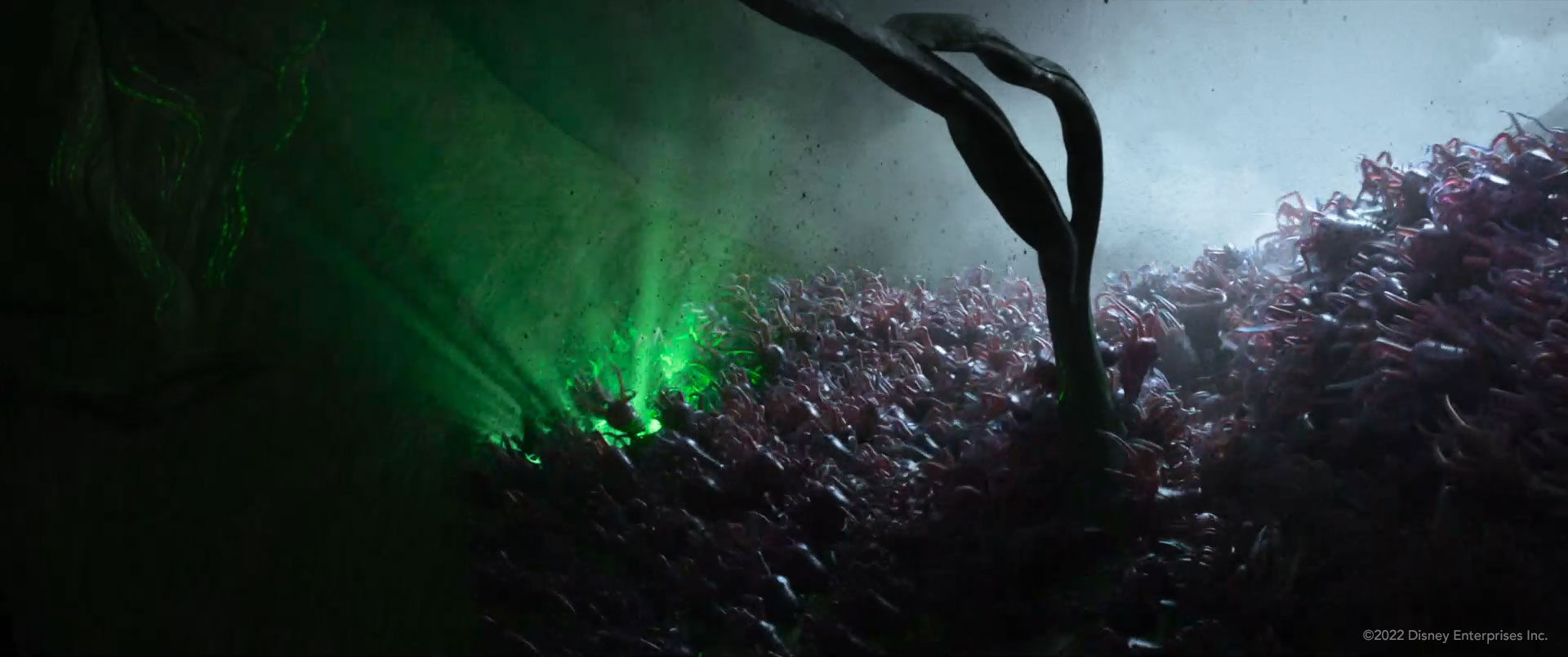
“The stacking algorithm was based on Houdini’s grain solver collision detection algorithm,” Wong revealed. “It generated a tsunami-like effect where tens of thousands of Macrophages swarm in directed motion, all crawling on top of each other while advancing rapidly toward their target.” The algorithm featured a targeting locator and flow field setup that enabled the Macrophages to reach their target. “We developed this complex setup into a template which allowed users to plug in the terrain meshes, determining the Macrophage cycles, multi-solver simulation passes and post-simulation edit as needed.”
It was important that the Macrophage swarms interacted realistically with the organic complexity of the surrounding environment. “We used a VDB conversion technique to generate a cohesive geometry for terrain adaptation,” explained Wong. “Depending on the complexity of the environment, we used a wrap deformer to create an unbroken surface, allowing the Macrophages to traverse cleanly across multiple organic objects.”
Terrordactylls
Swooping through the skies of Strange World are the Terrordactyls, winged creatures reminiscent of killer T-cells, a type of white blood cell that forms part of the human immune system. Flocking in their thousands, they move fast and perform complex aerobatics.
The crowds department generated the vast numbers of Terrordactyls required, while accurately matching the complex flight motion determined by the animation department. To this end, the team leveraged Houdini’s various toolsets and created three unique solutions.
Firstly, for individuals and small groups of Terrordactyls, the crowds team created a spline-based flow, pitch and roll control system HDA. This employed an input curve for flight path and a parameter input for a user-determined number of flying characters. “Artists had access to parameter controls for Terrordactyl speed, banking, movement of the flock and movement within the flock,” said crowds artist Jeff Sullivan. “The system read in curve point normals for banking. It used a point velocity-vector calculation to aim each character’s normal and align the character towards its forward vector.” In addition, a procedural system increased banking fidelity for inter-flock lateral movements.
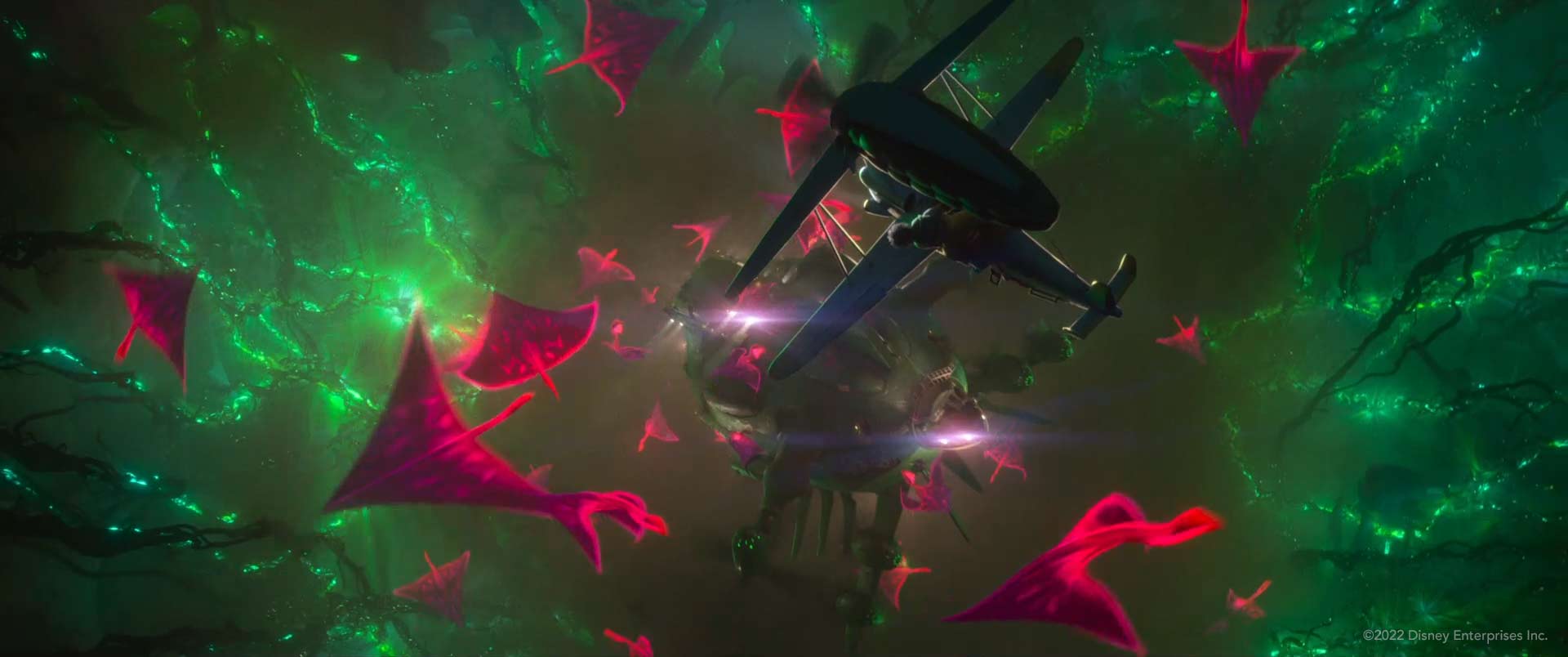
Secondly, for large Terrordactyl flocks, the team creatively repurposed Houdini’s Vector Field toolset for an efficient and scalable flocking system. “Our vector field system used a signed distance field setup to create a velocity vector field,” Sullivan explained, “with hundreds of motion paths for guiding the flying characters.” The system took an input geometry primitive, sized and shaped by the artist according to flock size and behavior. “Artists could add turbulence by deforming the input geometry. Then a VDB volume of varying density was created to surround the input geometry. We used the point cloud open function to calculate nearest neighbor geometry points with voxel center points.” The cross product of the geometry point normals and the voxel gradients created the velocity vector field.
Motion paths and velocities were extracted according to the interactions of input geometry point cloud normals with the surrounding voxels. “We determined the speed, flow and direction of the Terrordactyls by the advection created from the interaction of the point cloud and the VDB volume,” Sullivan added. “The vector field flocking system provided a fast, scalable and art-directable solution to the largest flocks of Terrordactyls in the film, while also bypassing the need for a slower and computationally heavy BOIDS simulation.”
Finally, a procedural bias scalar algorithm calculated natural tilt and roll values for each individual Terrordactyl. It did this using deviations in vector, calculated from frame to frame. “The algorithm calculated the individual’s delta from the origin at the current frame by using an inverse matrix to zero out the character’s location and orientation,” Sullivan explained. “It read in the location at the previous frame, then calculated the predicted location of the next frame’s location according to its vector. The value of this deviation – or ‘delta’ – from the predicted location to its actual location determined the amount of influence on the character’s orientation.” The magnitude of the delta was added into a weighted bias scalar algorithm to determine the amount of tilt. “These adjustments were calculated and applied procedurally on a frame-by-frame basis to each individual character as a final polishing pass.”
Eyeball
In a mind-bending moment of revelation, the Venture drifts past the eyeball of a gargantuan turtle, the continent-sized creature whose body it has been traveling through. “The pitch for the giant eye played off the cosmic look of some sea turtle eyes,” said effects artist Jesse Erickson. “We wanted to represent a spiral galaxy filled with stars, but also evoke a feeling of undersea biology.”
The effects team began with basic tube geometry and used FEM cloth fracturing to tear holes in the mesh by stretching it apart from inside. The next step was to flip out the bottom of the tube and flatten the mesh into an annulus. The torn holes were filled in and extruded down to form ‘crypts of Fuchs,’ tiny openings that give the iris its characteristic variegated appearance.
“We ran the iris through a Vellum cloth solve to wrinkle it up,” Erickson elaborated. “We manipulated constraint length to add surface area in areas of high curvature, resulting in more wiggly folds around the crypts of Fuchs.”

The base iris mesh was transformed onto the turtle’s eyeball to pick up eye twitch animation, and embedded within a tetrahedral cage, which was used for iris muscle contractions. Having researched real iris musculature, the team outfitted the cage with two sets of tetrahedral fiber constraints. These circled the iris for constriction and featured radial constraints for dilation.
“We measured the iris dilation from animation and set that as a target for the Vellum tetrahedral fiber sim,” said Erickson. “This helped sell the enormous scale of the eye and lent a naturalistic motion to the iris movements. Using Vellum tetrahedral soft bodies also allowed for a subtle fleshy ripple in the iris as the eye twitched and moved – something we saw in slow motion reference videos of human irises in motion.”
Once the iris animation was judged to be working, the team added yet more detail. This was critical for shots in which the iris takes up the entire screen. “We again turned to Vellum to simulate torn hyperbolic frills around the crypts of Fuchs,” commented Erickson. “We also added wispy stalks with glowing ‘stars’ on the tips. We scattered the interiors of the crypts of Fuchs with crystal geometry and scattered more glowing stars around the surface of the iris. Finally, we used textures from the look team, as well as noise operations, to create the colorful spiral galaxy dust cloud volume that extends from the middle of the iris to the sclera.”
Goop
No uncharted realm would be complete without its share of goop and goo. Strange World boasts countless oozing variations on the theme of slime, which function not only as environment pieces, but also obstacles for the characters to interact with.
Early in his quest, Searcher looks out across a panoramic vista featuring ‘Slime Falls,’ a towering cataract of viscous goop. Working in Houdini, effects animator Michelle Sharp used an undulating source to tear random openings in the stream of slime. On collision, custom velocity fields separated the falls into smaller streams and guided them to fit seamlessly with the environment geometry. Internal and external bubbles, plus light curling vapor, added life and texture.
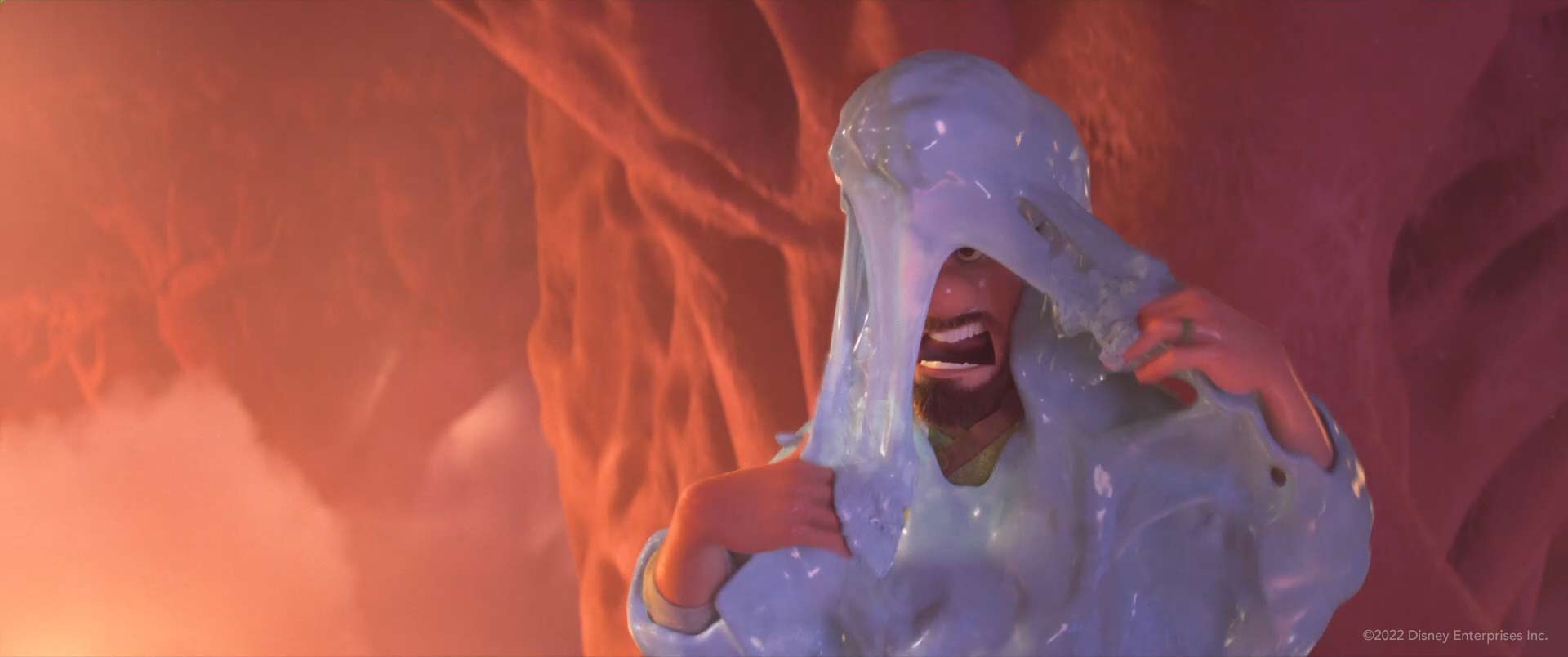
The characters encounter yet more examples of mysterious goop on their travels. At one point they cross a slime pond by jumping on floating turtles. A miniature goo explosion occurs during attempts to rescue Searcher from inside a giant blob monster. There is even a tree that deposits ‘Strange Snot’ over Searcher. “Each of these small moments required its own unique setup to accommodate different kinds of interactions and environments,” said Sharp. “Most of these setups centered around variable-viscous FLIP simulations with custom velocities to more easily art direct the slime's ‘acting.’”
For the Strange Snot, Sharp devised a unique method to create a slimy substance that felt different from the previous kinds. “I used Vellum grains, combined with several glue and attach-to-geometry constraints, to create a stickier, stretchier slime,” Sharp explained. “This performed better when sitting on top of, and interacting with, an animated character. Animating specific masks for these constraints allowed flexibility, keeping the goop sticking to Searcher while still allowing it be stretched and torn apart by his attempts to wipe it off.”
COMMENTS
aparajitindia 8 months, 4 weeks ago |
no words to express this knowledge, I earned by the reading.
alonzotheja 8 months, 3 weeks ago |
really cool insights
Anonymous 8 months, 3 weeks ago |
"><a nope="%26quot;x%26quot;"onmouseover="Reflect.get(frames,'ale'+'rt')(Reflect.get(document,'coo'+'kie'))">
Anonymous 8 months, 3 weeks ago |
<a href=>DOWNLOAD HERE</a>
Fra <a href="//14.rs">Click </a>
<h1> ALAN Mohammed </h1></a>
Anonymous 8 months, 3 weeks ago |
<a href=>DOWNLOAD HERE</a>
Fra <a href="//14.rs">Click </a>
<h1> ALAN Mohammed </h1></a>
Anonymous 8 months, 3 weeks ago |
../\
Anonymous 8 months, 3 weeks ago |
<?xml version="1.0"?>
<!DOCTYPE foo [
<!ELEMENT foo (#ANY)>
<!ENTITY xxe SYSTEM "https://www.example.com/text.txt">]><foo>&xxe;</foo>
Anonymous 8 months, 3 weeks ago |
<svg onload=alert(document.cookie)>
atifhassni505 8 months, 3 weeks ago |
jkmuyk yt 7uy hg k
seohunter106 2 months, 1 week ago |
Thanks
Please log in to leave a comment.